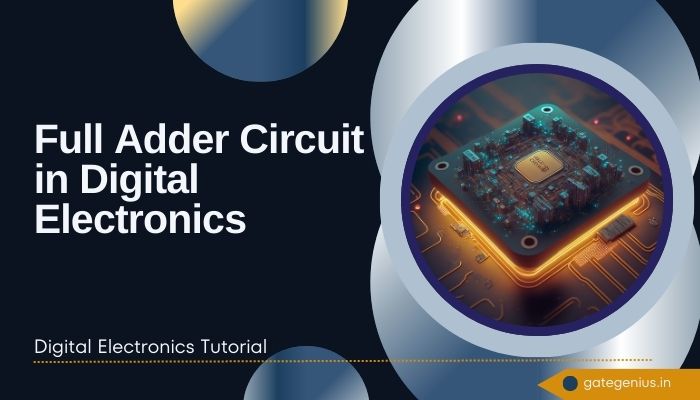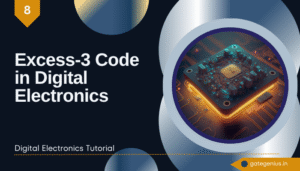In our journey through digital electronics, we discovered the Half Adder—a simple circuit for adding two bits. But to perform real calculations computers need to add multi-bit numbers, which requires considering a carry from a previous column. This is where the Full Adder comes in. As a fundamental unit of arithmetic logic, the Full Adder is the true workhorse behind processors, calculators, and ALUs. Understanding its operation is crucial for anyone studying computer architecture, digital logic design, or preparing for competitive exams like GATE and UGC NET. Let’s dive into what makes the Full Adder so essential.
What is a Full Adder? Definition
A Full Adder is a combinational logic circuit that adds three single-bit binary numbers. It is called “full” because it can handle three inputs, including a Carry-in (C_in), making it capable of being chained together to add numbers of any length. It has three inputs and two outputs, providing a complete solution for a single stage of binary addition.
Key Characteristics of a Full Adder
- Function: It performs the addition of three single-bit binary numbers (A, B, and C_in).
- Inputs: It has three input terminals:
A(Augend)B(Addend)C_in(Carry-in from a previous stage)
- Outputs: It has two output terminals:
S(Sum): Represents the least significant bit (LSB) of the result for that stage.C_out(Carry Out): Represents the carry generated to be passed to the next higher stage.
- Logic Gates: It can be constructed using two Half Adders and one OR gate, or directly with a combination of basic gates like XOR, AND, and OR.
- Usability: Unlike the Half Adder, the Full Adder is a complete circuit for a single bit addition stage and is used to build larger circuits like Ripple Carry Adders and Carry Look-Ahead Adders.
Truth Table of Full Adder
The truth table for a Full Adder defines its operation for all possible input combinations:
| A | B | C_in | S (Sum) | C_out (Carry) |
|---|---|---|---|---|
| 0 | 0 | 0 | 0 | 0 |
| 0 | 0 | 1 | 1 | 0 |
| 0 | 1 | 0 | 1 | 0 |
| 0 | 1 | 1 | 0 | 1 |
| 1 | 0 | 0 | 1 | 0 |
| 1 | 0 | 1 | 0 | 1 |
| 1 | 1 | 0 | 0 | 1 |
| 1 | 1 | 1 | 1 | 1 |
Boolean Expressions
The Boolean expressions derived from the truth table are:
- Sum (S) = A XOR B XOR C_in
- Carry (C_out) = (A AND B) OR (B AND C_in) OR (C_in AND A)
These expressions form the basis for the logic gate implementation.
Frequently Asked Questions (FAQ)
Q: What is the key difference between a Half Adder and a Full Adder?
A: A Half Adder can only add two bits (A and B) and has no input for a carry from a previous operation. A Full Adder can add three bits (A, B, and C_in), making it essential for building multi-bit adders.
Q: Why is the Full Adder called “Full”?
A: It is called “full” because it fully solves the problem of adding bits for a single column in a multi-digit binary addition, including handling an incoming carry. It requires no external circuitry to be chained together.
Q: How are Full Adders used to add larger binary numbers?
A: Multiple Full Adders are cascaded together to form Ripple Carry Adders. The C_out of one Full Adder is connected to the C_in of the next higher-order Full Adder. This chain allows for the addition of 4-bit, 8-bit, 16-bit, or larger numbers.
Q: What is the main disadvantage of a cascade of Full Adders?
A: The main disadvantage is propagation delay. In a Ripple Carry Adder, each Full Adder must wait for the carry signal from the previous one, which slows down the operation for very large numbers. This is solved using more advanced designs like the Carry Look-Ahead Adder (CLA).
Q: What are the primary applications of a Full Adder?
A: Full Adders are the core component of the Arithmetic Logic Unit (ALU) inside a CPU. They are used in processors, graphics cards, calculators, and any digital device that needs to perform arithmetic operations.
Conclusion
The Full Adder is a quintessential component in digital electronics, bridging the gap between simple theory and practical application. By efficiently handling the carry propagation, it enables the construction of complex computational systems from simple, logical blocks. Mastering the Full Adder is not just about understanding a circuit; it’s about understanding the very mechanism that allows computers to perform the calculations that power our digital world.
I hope you found this introduction to the Full Adder helpful. Don’t forget to share this post with friends and anyone preparing for exams like GATE or UGC NET!



